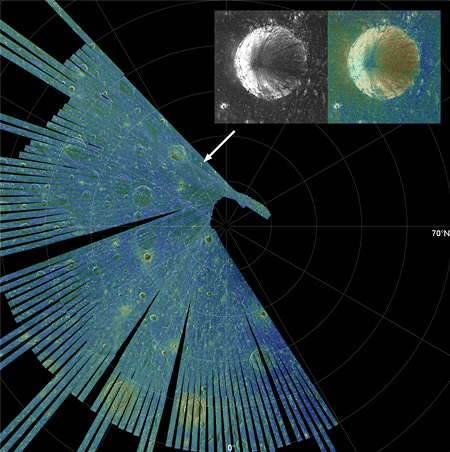[/caption]
Radar has been used since the 1960s to map the lunar surface, but until recently it has been difficult to get a good look at the Moon’s poles. In 2009, the Mini-SAR radar instrument on the Chandrayaan-1 spacecraft was able to map more than 95% of both poles at 150 meter radar resolution, and now the Mini-RF instrument on the Lunar Reconnaissance Orbiter — which has 10 times the resolution of the Mini-SAR — is about halfway through its first high-resolution mapping campaign of the poles. The two instruments are revealing there are likely massive amounts of water in the permanently shadowed craters at the poles, with over 600 million metric tons at the north pole alone. “If that was turned into rocket fuel, it would be enough to launch the equivalent of one Space Shuttle per day for over 2,000 years,” said Paul Spudis, principal investigator for the Mini-SAR, speaking at the annual Lunar Forum at the Ames Research Center in July.
Both Spudis and Ben Bussey, principal investigator for LRO’s Mini-RF shared images from their respective instruments at the Forum, highlighting polar craters that exhibit unusual radar properties consistent with the presence of ice.
They have found over 40 craters on the Moon’s north pole that exhibit these properties.
Both instruments provide details of the interior of shadowed craters, not able to be seen in visible light. In particular, a measurement called the circular polarization ratio (CPR) shows the characteristics of the radar echoes, which give clues to the nature of the surface materials in dark areas. The instruments send pulses of left-polarized radio waves to measure the surface roughness of the Moon. While smooth surfaces send back a reversed, right-polarized wave, rough areas return left-polarized waves. Ice, which is transparent to radio waves, also sends back left-polarized waves. The instruments measure the ratio of left to right circular polarized power sent back, which is the CPR.
Few places – even in our solar system — have a CPR greater than 1 but such places have thick deposits of ice, such as Martian polar caps, or the icy Galilean satellites. They are also seen in rough, rocky ejecta around fresh, young craters, but there, scientists also observe high CPR outside the crater rim such as in this image, below of the Main L crater on the Moon.

Most of the Moon has low CPR, but dozens of anomalous north pole craters, such as a small 8 km crater within the larger Rozhdestvensky crater, had a high CPR on the inside, with a low CPR on the rims. That suggests some material within the craters, rather than surface roughness, caused the high CPR signal.
“Geologically, we don’t expect rough, fresh surfaces to be present inside a crater rim but absent outside of it,” Spudis said. “This confirms the high CPR in these anomalous craters is not caused by surface roughness, and we interpret this to mean that water ice is present in these craters.”

Additionally, the ice would have to be several meters thick to give this signature. “To see this elevated CPR effect, the ice must have a thickness on the order of tens of wavelengths of the radar used,” he said. “Our radar wavelength is 12.6 cm, therefore we think that the ice must be at least two meters thick and relatively pure.”
Recent Mini-SAR images (top image) from LRO confirm the Chandrayaan-1 data, with even better resolution. The Mini-RF, Bussey said, is equivalent to a combination of the Arecibo Observatory and the Greenbank Radio telescope in looking at the Moon. “Our polar campaign will map from 70 degrees to the poles and so far we are very pleased with the coverage and quality of the data,” Bussey said.
Spudis said they are seeing less anamolous craters on the Moon’s south pole, but both he and Bussey are looking forward to comparing more data between the two radar instruments to learn more about the permanently shadowed craters on the Moon.
Additionally, other instruments on LRO will also provide insights into the makeup of these anomalous craters.
For more information see these NASA web pages:
NASA Radar Finds Ice Deposits at Moon’s North Pole
A Cool Look at a Lunar Crater


Great. Now let’s land a spacecraft right there!
just asking, does anyone know how the water actually got there?
That is an ingenious measurement technique.
But confusing for laymen. Apparently the term “circular polarization ratio” (CPR) as the ratio of left to right polarization waves hails from it being used as the circular polarization quality of an antenna, wherein an elliptically polarized signal would show up as CPR # 1. Here the applied signal contains both rotational modes, explaining the name.
Adding to the confusion is that the very similar “cross polarization ratio” (CPR) is the ratio between cross- and co-polarization modes in a signal, wherein the signal can be non-rotational. And this is presumably what you would use to look for specular reflection in light wavelengths instead.
Antenna guys may easily have their wires mixed.
@ SS:
‘Tis a mystery. In fact, the Moon’s full water cycle is problematic.
Wikipedia, as always, has a good description of what is Circular Polarization of electromagnetic waves.
P.S. Is it just me or does anyone else get this annoying message:
… after submitting a comment?
However, after refreshing the page, I then see that my comment has been submitted.
IVAN-
We’re working on fixing that problem, as well as fixing a few other bugs and details on the new design (larger font, image captions, etc).
Thanks for the great news Nancy! “…over 600 million metric tons at the north pole…” AND the fact that some of it appears to be ‘relatively pure’ water ice is more than simply amazing news, it means far less processing prior to use~~~
Now… if it is eventually found that the ice contains organic material .. THAT would be something to write home about!~
Now this is what I call awesome news!!
I hope it actually pans out.
@Scrambler Sinister (and @Torbjorn Larsson OM)
AFAIU, that article deals primarily with water at other locations than the poles. I believe that “the polar ice caps” 😉 on the Moon are thought to originate mainly from old comet impacts. The ice then survived in the dark places of the Moon for us to dig up now.
Regards,
/hydrazine
Hydrazine, ’tis part of the mystery. 😀
No, actually AFAIU it may well be that the water cycle transported some of the impact water (which is part of the cycle) to its dark reservoirs. And it was a handy reference to answer an open ended question.
But of course you are correct in that direct impacts could have (ought to have) have imparted most of the found quantities!
Interesting, so am I right in understanding… if the signal is bounced off of ice mud, the signal would likely show nothing was there?
These are deep impact craters where the sunlight at the poles impacts the surface at shallow angles and doesn’t reach down beneath the rim.. The rest of the moons surface should have lost all ice to sublimation being devoid of an atomosphere. The crater is 20-30 degrees kelvin and the ice is mixed in with mineral rock and soil. There is not any evidence of liquid water beneath the surface that may have risen up, to subsequently freeze, and fill this impact basin. Only ice has been discovered on the moon,and there is no evidence of liquid water. The moon does not have any significant interior like earth has containing radioactive elements that can heat up metamorphize and melt rocks and ice. Too bad buzz armstrong didn’t step out and walk on ice.
Cool ROCK! Right Jim? BTW, was that Buzz Aldrin or Neil Armstrong???
@ Jim Henson:
This is contentious, but according to many results it has. A liquid core explains the remnant magnetism historically, and apparently some orbit features now.
I just discussed and gave the references over on the thread on the Moon’s water cycle, which link I gave above, so please see there. The magnetism paper is pretty convincing, and it was presented to me at an astrobiology course so vetted by at least one researcher (i.e. the prof), so it is likely Moon has a core and it was once liquid.
What prompted my question about its activity was precisely the possibility that the water cycle could get contributions from on down. We can’t exclude it, and an active or once active core raises the likelihood.